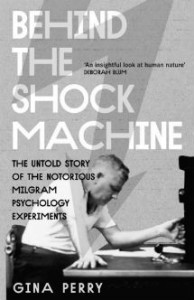Remember That Famous Study about Obedience to Authority? Here’s How Stanley Milgram Got It Wrong
REVIEWS, 10 Mar 2014
According to conventional wisdom, psychologist Stanley Milgram’s famous experiment revealed that human beings are hardwired to obey authority. But author Gina Perry looked at Milgram’s data—and she’s not convinced.

Behind the Shock Machine: The Untold Story of the Notorious Milgram Psychology Experiments
by Gina Perry
The New Press, $26.95, 341 pages
What if one of the most famous and influential psychology experiments of the twentieth century was proven invalid? In October 1963, the New York Times reported the findings of an experiment by psychologist Stanley Milgram: “Sixty-five Percent in Test Blindly Obey Order to Inflict Pain.” The headline is typical of the standard version of the story, which Milgram himself promoted: In his lab, he established a disturbing, universal truth about human obedience to authority.
In Behind the Shock Machine, Gina Perry shows that nearly every crucial detail of that standard version is either misleading or false. We already knew that aspects of Milgram’s experiment were deceptive. He led his research subjects to believe that, by pushing a button on an electronic device, they would give painful, perhaps dangerous, electric shocks to another volunteer when he responded incorrectly. In fact, the machine was fake and the other volunteer was a member of Milgram’s staff, who feigned cries of protest each time he was “shocked.”
Perry’s reassessment of the experiment reveals the depth of deception that Milgram undertook in order to “discover” and promote his findings. Although popular understanding focuses on a single experiment, Milgram in fact conducted more than 20, with varying conditions, involving nearly 800 volunteers. Overall, a majority of his subjects actually refused to obey. Milgram either de-emphasized or actively suppressed evidence that ran contrary to his desired conclusions.
What Milgram counted as “obedience” is equally misleading. Recordings of the experiments reveal subjects who repeatedly refused to comply, but reluctantly continued when the researcher insisted. Some protested as many as 24 times before continuing.
To Milgram, as long as they pushed the button, they were “blindly obedient.”
Perry’s richly detailed reassessment of the Milgram experiments makes for terrific reading. Her absorbing narrative redeems the humanity of the people who participated in those experiments and challenges us to rethink what we take to be their fundamental lesson about human nature.
___________________________
Andy Lee Roth teaches sociology at Sonoma State University.
Go to Original – yesmagazine.org
DISCLAIMER: The statements, views and opinions expressed in pieces republished here are solely those of the authors and do not necessarily represent those of TMS. In accordance with title 17 U.S.C. section 107, this material is distributed without profit to those who have expressed a prior interest in receiving the included information for research and educational purposes. TMS has no affiliation whatsoever with the originator of this article nor is TMS endorsed or sponsored by the originator. “GO TO ORIGINAL” links are provided as a convenience to our readers and allow for verification of authenticity. However, as originating pages are often updated by their originating host sites, the versions posted may not match the versions our readers view when clicking the “GO TO ORIGINAL” links. This site contains copyrighted material the use of which has not always been specifically authorized by the copyright owner. We are making such material available in our efforts to advance understanding of environmental, political, human rights, economic, democracy, scientific, and social justice issues, etc. We believe this constitutes a ‘fair use’ of any such copyrighted material as provided for in section 107 of the US Copyright Law. In accordance with Title 17 U.S.C. Section 107, the material on this site is distributed without profit to those who have expressed a prior interest in receiving the included information for research and educational purposes. For more information go to: http://www.law.cornell.edu/uscode/17/107.shtml. If you wish to use copyrighted material from this site for purposes of your own that go beyond ‘fair use’, you must obtain permission from the copyright owner.